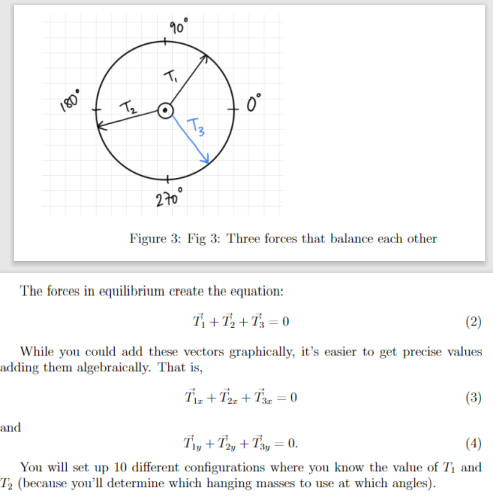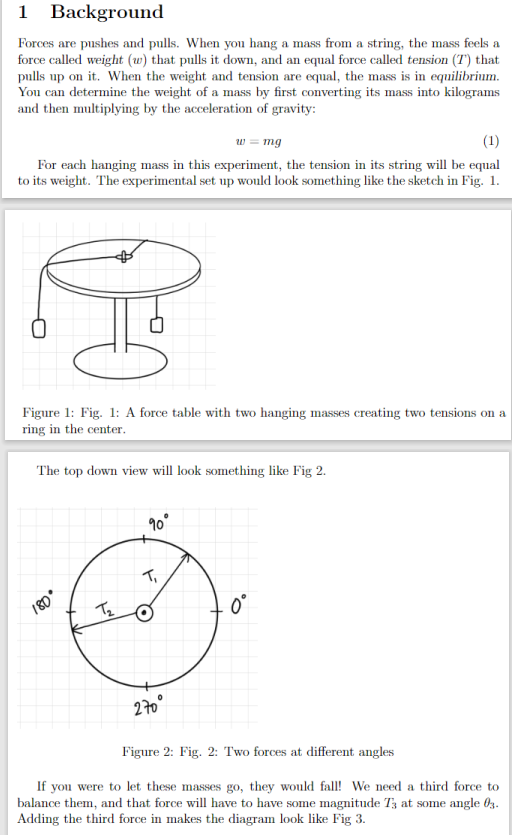Draw a different configuration, and make it a diagram similar to Fig. 3. Specify each mass and angle you’d be using. B. Determine the tensions T1 and T2 which would be created by each hanging
Draw a different configuration, and make it a diagram similar to Fig. 3. Specify each mass and angle you’d be using. B. Determine the tensions T1 and T2 which would be created by each hanging
International Edition---engineering Mechanics: Statics, 4th Edition
4th Edition
ISBN:9781305501607
Author:Andrew Pytel And Jaan Kiusalaas
Publisher:Andrew Pytel And Jaan Kiusalaas
Chapter1: Introduction To Statics
Section: Chapter Questions
Problem 1.1P: A person weighs 30 lb on the moon, where g=5.32ft/s2. Determine (a) the mass of the person; and (b)...
Related questions
Question
A. Draw a different configuration, and make it a diagram similar to Fig. 3. Specify
each mass and angle you’d be using.
B. Determine the tensions T1 and T2 which would be created by each hanging
mass
C. find the unknown components of T3
D.calculate the magnitude and direction of T3

Transcribed Image Text:180°
T₂
and
90°
T₁
O
270°
T3
0°
Figure 3: Fig 3: Three forces that balance each other
The forces in equilibrium create the equation:
T₁+T₂+73=0
(2)
While you could add these vectors graphically, it's easier to get precise values
adding them algebraically. That is,
T₁Z+T2z+T3=0
(3)
T₁+T2y +T3y = 0.
(4)
You will set up 10 different configurations where you know the value of T₁ and
T₂ (because you'll determine which hanging masses to use at which angles).

Transcribed Image Text:1 Background
Forces are pushes and pulls. When you hang a mass from a string, the mass feels a
force called weight (w) that pulls it down, and an equal force called tension (T) that
pulls up on it. When the weight and tension are equal, the mass is in equilibrium.
You can determine the weight of a mass by first converting its mass into kilograms
and then multiplying by the acceleration of gravity:
w = mg
(1)
For each hanging mass in this experiment, the tension in its string will be equal
to its weight. The experimental set up would look something like the sketch in Fig. 1.
3
Figure 1: Fig. 1: A force table with two hanging masses creating two tensions on a
ring in the center.
The top down view will look something like Fig 2.
180°
T₂
90°
T₁
270°
Figure 2: Fig. 2: Two forces at different angles
If you were to let these masses go, they would fall! We need a third force to
balance them, and that force will have to have some magnitude 73 at some angle 03.
Adding the third force in makes the diagram look like Fig 3.
Expert Solution
This question has been solved!
Explore an expertly crafted, step-by-step solution for a thorough understanding of key concepts.
This is a popular solution!
Trending now
This is a popular solution!
Step by step
Solved in 5 steps with 10 images

Knowledge Booster
Learn more about
Need a deep-dive on the concept behind this application? Look no further. Learn more about this topic, mechanical-engineering and related others by exploring similar questions and additional content below.Recommended textbooks for you

International Edition---engineering Mechanics: St…
Mechanical Engineering
ISBN:
9781305501607
Author:
Andrew Pytel And Jaan Kiusalaas
Publisher:
CENGAGE L

International Edition---engineering Mechanics: St…
Mechanical Engineering
ISBN:
9781305501607
Author:
Andrew Pytel And Jaan Kiusalaas
Publisher:
CENGAGE L